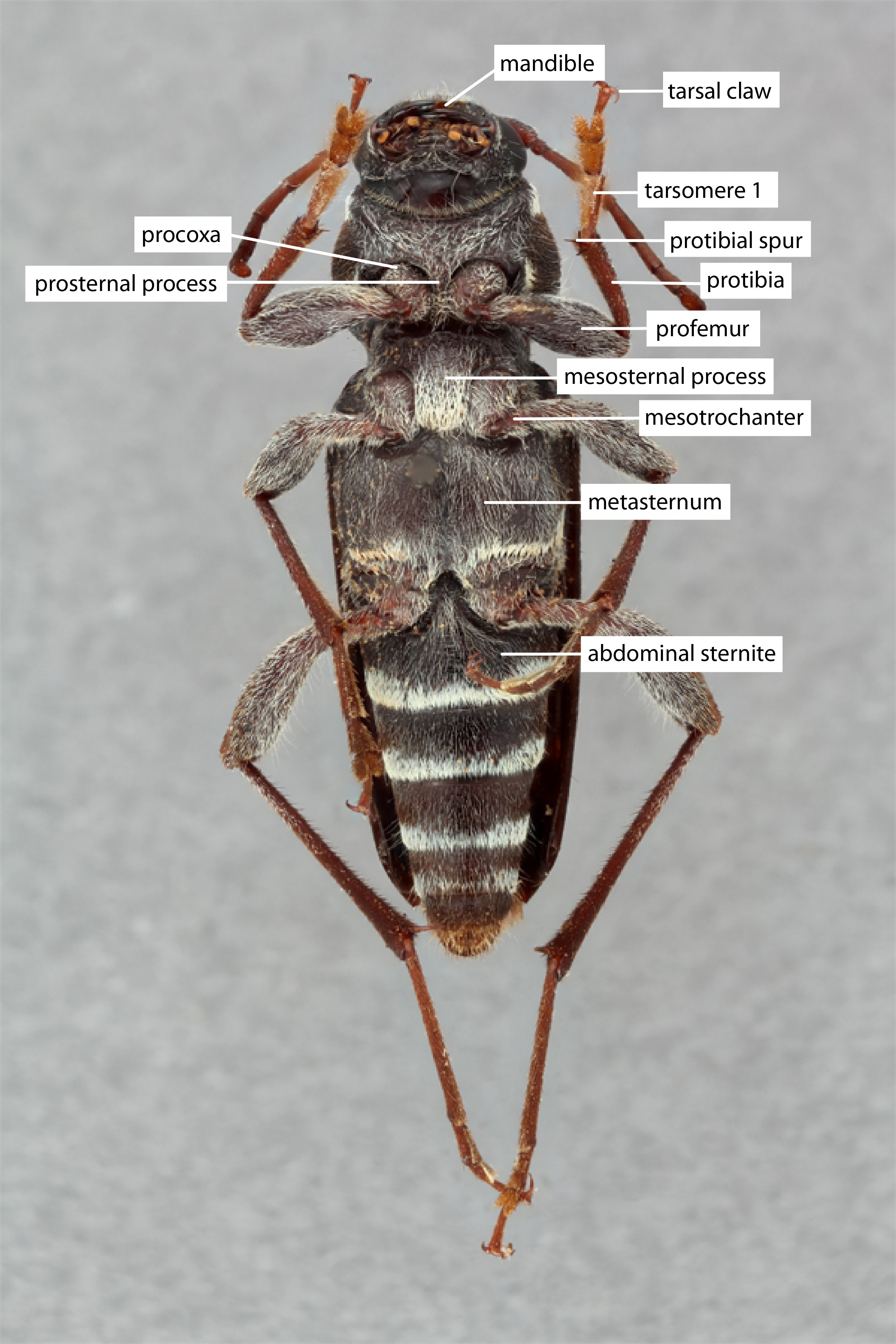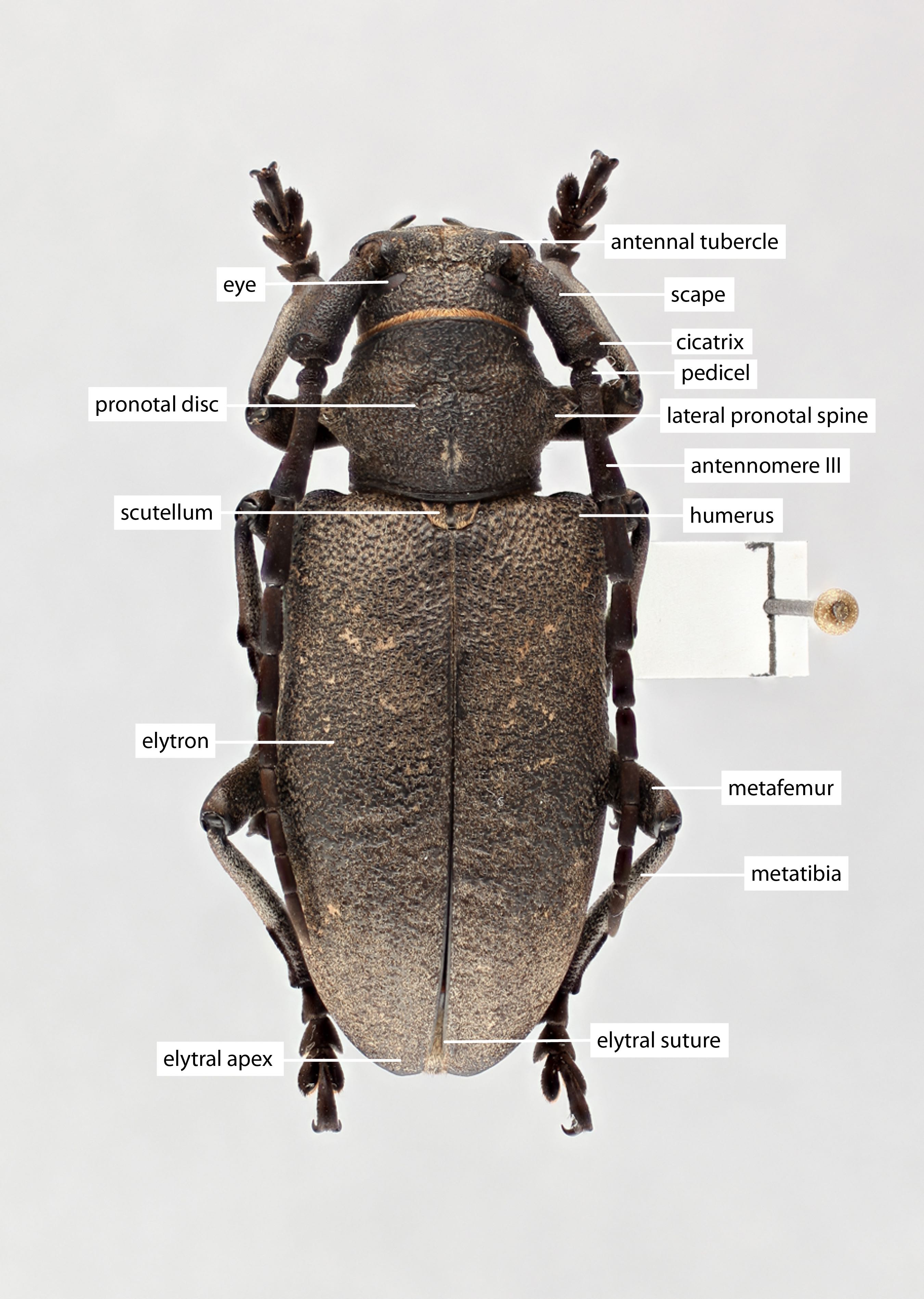Body length: 12–19 mm.
Eyes: eye interommatidial setaeseta:
a sclerotized hair-like projection of the cuticle
absent, eye deeply emarginateemarginate:
notched at the margin > half width or divided-max one row of facets between, eye ommatidial density coarse.
> half width or divided-max one row of facets between, eye ommatidial density coarse.
Antennaeantenna:
in larval and adult insects, paired segmented appendages, borne one on each side of the head, functioning as sense organs and bearing a large number of sensilla
: antennal length reaches between basebase:
the part of any appendage or structure that is nearest the body
and end of elytraelytron:
the leathery forewing of beetles, serving as a covering for the hind wings, commonly meeting opposite elytron in a straight line down the middle of the dorsum in repose
or reaching/surpassing end of body, antennal flagellar segments elongateelongate:
much longer than wide
, scapescape:
the first proximal segment of the antenna smooth/punctate at apexapex:
smooth/punctate at apexapex:
end of any structure distad to the base
, antennal segment 3 > scapescape:
the first proximal segment of the antenna .
.
Pronotumpronotum:
the upper and dorsal part of the prothorax
: pronotumpronotum:
the upper and dorsal part of the prothorax
shape transversetransverse:
broader than long
, pronotumpronotum:
the upper and dorsal part of the prothorax
lateral armature absent or blunt tubercule.
Prosternum: prosternal processprosternal process:
a posterior extension of the prosternum between the coxae dilated at apexapex:
dilated at apexapex:
end of any structure distad to the base
, procoxal cavities closed posteriorly.
Elytraelytron:
the leathery forewing of beetles, serving as a covering for the hind wings, commonly meeting opposite elytron in a straight line down the middle of the dorsum in repose
: elytral length reaching or close to end of abdomen, elytral apicesapex:
end of any structure distad to the base
rounded or truncatetruncate:
cut off squarely at the tip
or emarginateemarginate:
notched at the margin , elytral color pattern present.
, elytral color pattern present.
Legs: visible tarsomerestarsomere:
subdivision or article of the tarsus, usually numbering from two to five : 4, femora robust, protibial spursprotibial spur:
: 4, femora robust, protibial spursprotibial spur:
sclerotized spine(s) located at the distal tibia; can be single, double, or absent : 2, tarsal clawstarsal claw:
: 2, tarsal clawstarsal claw:
usually paired claws of the pretarsus, at the distal end of the leg simple.
simple.
Elongate. Relatively slender antennaeantenna:
in larval and adult insects, paired segmented appendages, borne one on each side of the head, functioning as sense organs and bearing a large number of sensilla
, eleven sections. Pronotumpronotum:
the upper and dorsal part of the prothorax
strongly narrowed in front and covered with irregular elevations. Semicircular scutellumscutellum:
a small sclerite located directly posterior to the pronotum, bordered laterally by the elytra . Elytraelytron:
. Elytraelytron:
the leathery forewing of beetles, serving as a covering for the hind wings, commonly meeting opposite elytron in a straight line down the middle of the dorsum in repose
tapering from the basebase:
the part of any appendage or structure that is nearest the body
to the apexapex:
end of any structure distad to the base
, the latter indented and bordered by a fringe of large stiff bristles. Narrow, flat prosternal processprosternal process:
a posterior extension of the prosternum between the coxae , the same height as the anterior coxae. Rather long and slender legs (adapted from Villiers 1946Villiers 1946:
, the same height as the anterior coxae. Rather long and slender legs (adapted from Villiers 1946Villiers 1946:
Villiers A. 1946. Coléoptères Cérambycides de l'Afrique du Nord. Faune de l'Empire Français, ORSC Paris 5: 1–152, 275 figs. http://www.cerambycoidea.com/titles/villiers1946.pdf).
Mimoniphona
The stiff bristles bordering the elytral apexapex:
end of any structure distad to the base
, tapering elytraelytron:
the leathery forewing of beetles, serving as a covering for the hind wings, commonly meeting opposite elytron in a straight line down the middle of the dorsum in repose
, and often divided eyes make this genus distinctive among conifer feeders.
Palearctic, Indomalaya, Afrotropical
broadleaf; Pinus, Cedrus
68 species and 2 more sspp; (Hamatoniphona) 1 sp.; (Spinoniphona) 1 sp. Conifers: N. (Niphona) picticornis.
Nyphona, Dejean, 1835 [for Niphona]
Aelara, Thomson, 1864Thomson, 1864:
Thomson J. 1864–65. Systema cerambycidarum ou exposé de tous les genres compris dans la famille des célrambycides et familles limitrophes. H. Dessain, Liége, 578 pp. [1864: pp. 1–352; 1865: 353–578; Also published in Mémoires de la Société Royale des Sciences de Liége 19 [1866]: 1–578]. [for Niphona]
Ocheutes, Thomson, 1864Thomson, 1864:
Thomson J. 1864–65. Systema cerambycidarum ou exposé de tous les genres compris dans la famille des célrambycides et familles limitrophes. H. Dessain, Liége, 578 pp. [1864: pp. 1–352; 1865: 353–578; Also published in Mémoires de la Société Royale des Sciences de Liége 19 [1866]: 1–578]. [for Niphona]
Camptocnema, Thomson, 1864Thomson, 1864:
Thomson J. 1864–65. Systema cerambycidarum ou exposé de tous les genres compris dans la famille des célrambycides et familles limitrophes. H. Dessain, Liége, 578 pp. [1864: pp. 1–352; 1865: 353–578; Also published in Mémoires de la Société Royale des Sciences de Liége 19 [1866]: 1–578]. [for Niphona]
Falsoniphona, Pic, 1925 [for Niphona]
Subgenus Niphona Mulsant, 1839
Subgenus Hamatoniphona Pic, 1936
Subgenus Spinoniphona Hua, 1989